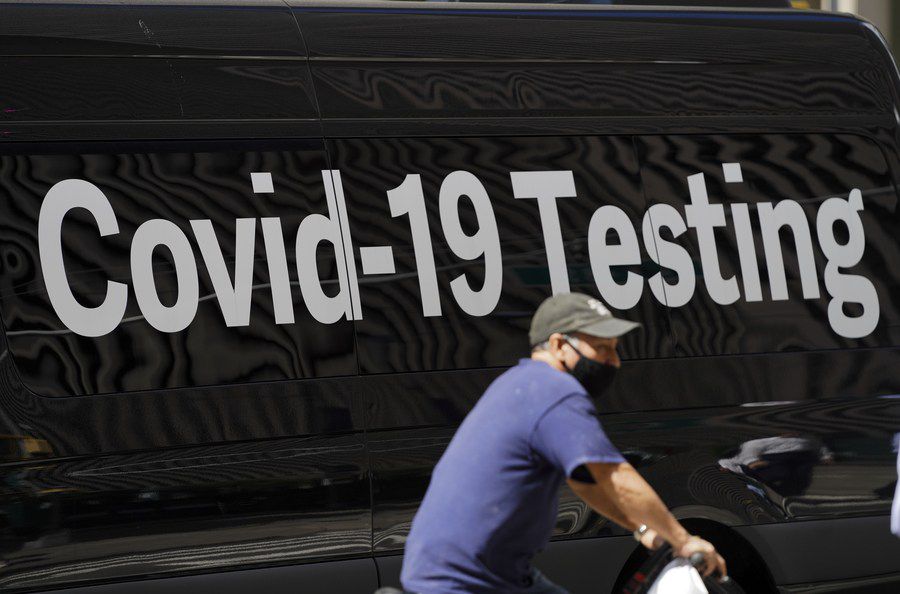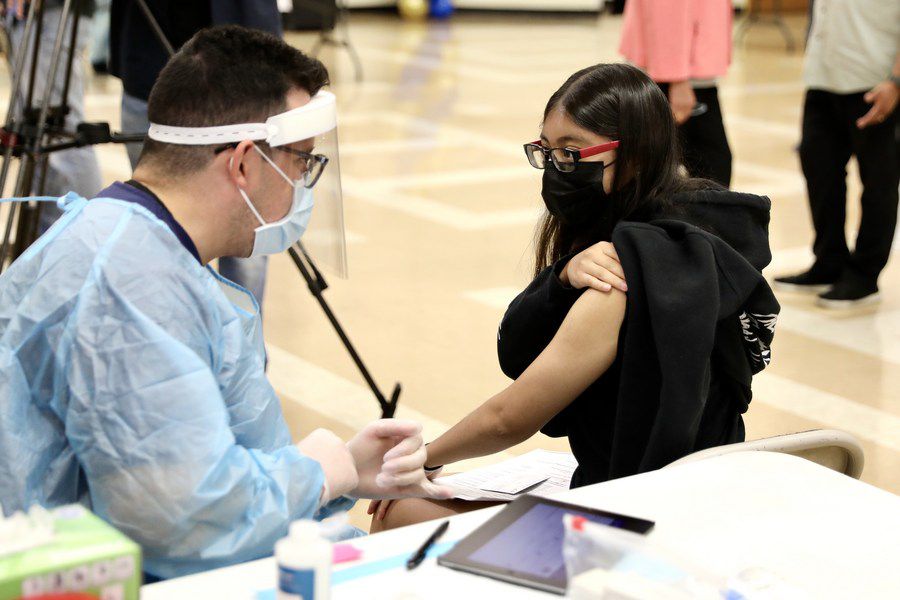U.S. navigates COVID-19 pandemic amid surging cases, rising costs

A cyclist rides past a COVID-19 mobile test site in New York City, the United States, Aug. 2, 2021.(Xinhua/Wang Ying)
Despite the government's ongoing vaccination push, tens of millions of eligible Americans still have not received even a single dose. Biden said that group is prolonging the pandemic and contributing to anxieties that impact the economy, adding "this is a continuing pandemic of the unvaccinated."
NEW YORK, Sept. 5 (Xinhua) -- Staggering into the 19th month in the fight against COVID-19, the U.S. administration is trying to clear an intergenerational anti-pandemic roadmap by announcing a plan worth 65 billion U.S. dollars to counter future pandemics, and boosting vaccination to limit the spread of the coronavirus, even if the virus is far from being tamed with surging cases and a new prevalent variant called Mu.
The 7-day average of confirmed cases of the pandemic stood at 160,901 in the United States on Friday, with its 14-day change recording an 7-percent rise. COVID-19-related deaths were 1,544 on Friday, with a 14-day change realizing a 53-percent hike, according to The New York Times.
FUTURE PLAN
On Friday, the U.S. administration unveiled a 10-year plan worth 65.3 billion dollars to help the nation combat future biological threats after the COVID-19 pandemic subsides.
Since the next pandemic will likely be "substantially different" from the COVID-19, the U.S. government must start preparing now for any future viral threat, said Eric Lander, U.S. President Joe Biden's science advisor and director of the Office of Science and Technology.
The plan, released in a 27-page document titled "American Pandemic Preparedness: Transforming Our Capabilities," calls for billions of dollars to transform the ability to prevent, detect, and rapidly respond to pandemics, including investments in vaccines, therapeutics, diagnostics, early warning, personal protective equipment, as well as global pandemic preparedness.
Particularly, the plan proposes 15-20 billion dollars to jump-start the efforts. The funds will be managed by a new "mission control" office at the Department of Health and Human Services that's closely overseen by Congress.
The future plan seems promising. Currently, however, Americans remain in the mire.
According to a recent NPR/PBS NewsHour/Marist National Poll, the number of Americans who approve of what President Joe Biden is doing to end the pandemic is at its lowest level since he took office.
"At a moving average of 154,000 confirmed cases per day nationwide, new COVID-19 infections are at their highest rate since Biden's first days in office and before vaccines were widely available. Younger people who are unvaccinated are driving the increase, and people in their 30s and 40s, as well as children, are getting severely ill and dying from COVID-19 more often than at other times since the virus emerged," the Public Broadcasting Service quoted the poll as indicating.
Facing a surging Delta, fewer Americans are unwilling to get vaccinated compared to late June and about half of Americans support more robust pandemic policies, including employer mandates for COVID-19 vaccines, it added.
Roughly two months into its fourth wave, the United States saw a decline in the recent growth rate of daily infections, suggesting that a peak is nigh, reported Business Insider on Saturday. Nationally, daily cases rose 9 percent in the last week, compared to double-digit weekly increases throughout July and early August.
"I do think that we're going to see the Delta surge wane, like others have," said Jeffrey Morris, director of biostatistics at the University of Pennsylvania.
Daily hospitalizations could decline soon, given that much of the population has some form of immunity, said Morris, adding that 62 percent of Americans are at least partially vaccinated and 12 percent have had a confirmed case of COVID-19.
VACCINATION DILEMMA
As of Saturday, the Mu variant of COVID-19, also known as B.1.621 and classified as a "variant of interest" by the World Health Organization, was present in every U.S. state except Nebraska, according to Outbreak.info, an epidemiology and genomic database from Scripps Research.
The strain is now most prevalent in Alaska where it accounts for 4 percent of 3,837 sequenced samples, and in terms of raw numbers, California has the most Mu cases at 384 out of 139,930 samples, according to the data.
Concerns about the Mu variant stem from its mutations, which may evade certain antibodies, "not only monoclonal antibodies, but vaccine-induced antibodies," said Anthony Fauci, Chief Medical Advisor to the White House.
But Fauci said the Mu variant is not considered an "immediate threat" and stressed the importance of vaccination.
Currently, the Delta variant remains dominant in the United States and cases of Mu have been relatively limited.
Biden on Friday blamed the coronavirus pandemic for a surprisingly weak jobs report, calling out Americans to get vaccinated amid the spread of the highly infectious Delta.
"There's no question the Delta variant is why today's job report isn't stronger," the president said at the White House shortly after the data came out. "We need to make more progress in fighting the Delta variant."

A student prepares to receive the COVID-19 vaccine at the Woodrow Wilson Senior High School in Los Angeles, California, the United States, on Aug. 30, 2021. (Xinhua)
Despite the government's ongoing vaccination push, tens of millions of eligible Americans still have not received even a single dose. Biden said that group is prolonging the pandemic and contributing to anxieties that impact the economy, adding "this is a continuing pandemic of the unvaccinated."
In the meantime, the White House has said Americans should start getting boosters of Pfizer and Moderna as of Sept. 20, but leading experts who regulate vaccinations in the United States worry that the country doesn't yet have evidence to support that move.
"If we're going to move in this direction, I want to see the data," registered nurse Lynn Bahta, who serves on the independent advisory committee on vaccines under the U.S. Centers for Disease Control and Prevention (CDC), said during a meeting earlier this week.
The heads of the CDC and the U.S. Food and Drug Administration are now urging the White House to walk back its booster recommendation, thinking the booster rollout as "risking over-vaccination" before enough data is gained, The New York Times reported Friday.
MORE PATIENTS, HIGHER COSTS
New cases have fallen in California, but hospitalizations have not followed the same trend.
As of Thursday, 8,630 people were hospitalized with the virus across the state, more than five times of the number hospitalized on July 1, leading to some hospitals running out of intensive care beds, reported The Hill over the weekend.
Florida registered more COVID-19-related deaths than ever before: Its coronavirus death toll climbed by 2,345 people this week, 36 percent higher than last week.
As Delta spreads nationwide, hospitalizations among individuals under 18 for the virus rose nearly five-fold from late June to mid-August, according to a CDC study released on Friday. In addition, hospitalizations were 10 times higher among unvaccinated adolescents than among those vaccinated.
While the pandemic remains bleak in many U.S. states and among some groups, another harsh reality looms large for Americans: They will pay significantly more for COVID-19 medical care, because insurers are now treating the coronavirus more like any other disease, no longer fully covering the costs, The Times reported this week.

A healthcare worker wheels a patient into an ambulance outside a hospital in New York, the United States, on Jan. 18, 2021. (Photo by Michael Nagle/Xinhua)
Federal law still requires insurers to cover testing when there is a medical reason for seeking care, such as exposure to the disease or a display of symptoms. But more of the tests sought now don't meet the definition of a "medical reason" and are instead for monitoring, according to the report.
Because insurers are not required to cover such regular testing, some patients have already received testing bills as high as 200 U.S. dollars for routine screenings, said the report, adding that "some of the highest bills, however, will probably involve COVID-19 patients who need extensive hospital care now that most insurers no longer fully cover those bills."
In an attempt to avoid rising pandemic-related costs, American Airlines said on Friday that the company would not provide special leave from next month to unvaccinated employees who have to quarantine.
Also on Friday, Alaska Airlines said that it had stopped special pay for unvaccinated employee absences due to a COVID-19 infection or exposure.
The moves by the two airlines came after United Airlines last month became the first U.S. carrier to require its staff members be vaccinated against COVID-19.
Photos
 Dance show saluting traditional culture of the Song Dynasty makes its debut
Dance show saluting traditional culture of the Song Dynasty makes its debut Village in SW China’s Yunnan embraces prosperity through agricultural tourism
Village in SW China’s Yunnan embraces prosperity through agricultural tourism Eighth birthday for pair of giant pandas celebrated in Haikou, Hainan province
Eighth birthday for pair of giant pandas celebrated in Haikou, Hainan province Olympic gold medalists portrayed in Shanxi artist’s polymer clay sculptures
Olympic gold medalists portrayed in Shanxi artist’s polymer clay sculptures
Related Stories
- U.S. needs to work with China in pandemic fight: U.S. economist
- Hong Kong reports 8 new imported COVID-19 cases
- Feature: Nepali traders import goods from China earlier for festival season over fear of COVID-related disruption
- Chinese mainland reports no new locally transmitted COVID-19 cases
- Russia criticizes U.S. report on COVID-19 origins
Copyright © 2021 People's Daily Online. All Rights Reserved.






